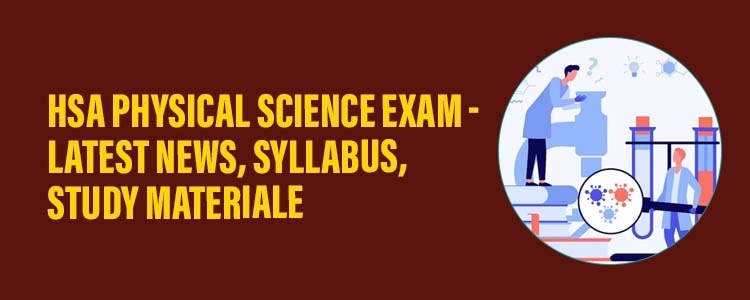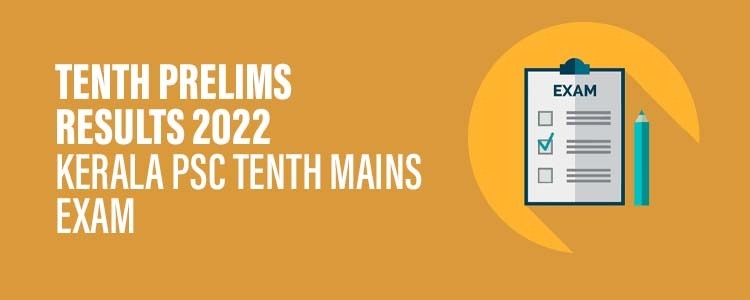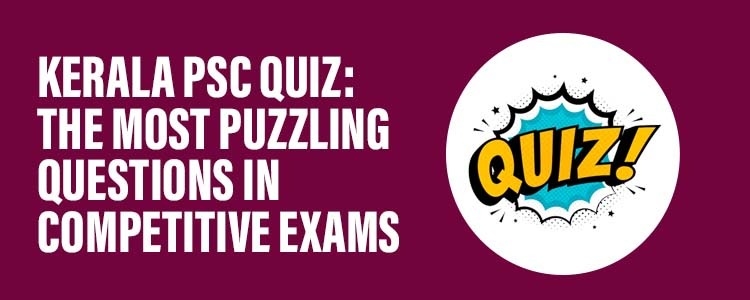HSA Physical Science Exam – Latest News, Syllabus, Study Material

Contents
1. HSA Physical Science Exam 2023
2. HSA Physical Science Exam Pattern
3. HSA Physical Science Syllabus
4. HSA Physical Science Cut Off
5. HSA Physical Science Coaching
6. HSA Physical Science Rank Lists
" The High School Assistant Rank lists have been entangled in a court order strangling the aspirations of a lot of candidates who had appeared for the common OMR test dated 2nd August 2018. The notification pertains to category no. 227/2016 - High School Assistant (Physical Science) which was gazetted on 30th August 2016. The recruitment was held for all 14 districts with an anticipated number of vacancies. As per the gazette, the candidates with a degree in the concerned subject, either Physics or Chemistry, and a B.Ed. or BT degree in the concerned subject are eligible to apply for this post. However, the shortlists released on 17th December 2018 were quashed in compliance with the court order that the post is only meant for candidates who have taken either Physics or Chemistry as the subsidiary subjects too. This has created a great dilemma among the candidates and the reverse petition was filed demanding quashing the order produced as an act of injustice in the Prima face. However, the candidates were allowed to attend the interview provisionally for the various districts. Now, the most intriguing fact is that the candidates who have the Physics-Chemistry as the major-subsidiary subject combo would not have qualified KTET category 3 as the requisite qualification for joining the service. That’s where the upcoming KTET exams proposed for May 2023 play a crucial role. Scroll down to know more about the upcoming notification and the requisite qualification for the HSA Physical Science exam."
HSA Physical Science Exam 2023
The High School Assistant Physical Science Exam 2023 is propounded to be notified by the Kerala Public Service Commission sooner or later. The latest rank list for various districts was released in the month of October 2020 thereby as per the usual procedures of Kerala PSC, the rank list will expire after a stipulated period of three years which is due for the upcoming month of October 2023. Subsequently, the Kerala Public Service Commission will also be notifying the new recruitment for the above post at most 4 to 2 months before the expiry of the old rank list. The candidates can therefore avidly expect the HSA Physical Science notification 2023 any time in the month of June.
|
HSA Physical Science Exam Date 2023 |
Will be released soon |
|
Official Website Link | |
|
HSA Physical Science Admit Card |
Will be released soon |
|
HSA Physical Science Answer Key | |
|
HAS Physical Science Rank Lists |
HSA Physical Science Exam Pattern
The HSA Physical Science exam consists of two parts viz., part A and part B. The question paper is conducted for a total of 100 marks for a duration of 75 minutes. However, the Kerala PSC has updated the duration of most exams to 1 hour 30 minutes, adding 15 minutes extra to the conventional timings followed till lately.
|
Total Number of Questions |
100 |
|
Time Duration |
1 hour 15 minutes |
|
Marks for correct response |
1 |
|
Negative marks for wrong response |
0.33 |
|
Mode of Test |
Offline OMR Mode |
HSA Physical Science Syllabus
The HSA Physical Science Syllabus 2023 for Part A covers general syllabus like a) Renaissance and freedom movement, b) General Knowledge and Current Affairs, and c) Teaching Aptitude and related Pedagogy. And the HSA Physical Science Part B covers the core topics stretched across 8 modules. The last updated topics for the HSA Physical Science Exam are included below that pertain to the 2018 HSA Physical Science Syllabus.
HSA Physical Science Syllabus 2023 (Part A)
|
Module-I |
Renaissance and Freedom movement |
|
Module-II |
General Knowledge and current affairs |
|
Module-III |
Methodology of teaching the subject
|
HSA Physical Science Syllabus 2023 (Part B)
|
Module-I |
|
|
Module-II |
|
|
Module-III |
|
|
Module-IV |
|
|
Module-V |
|
|
Module VI |
|
|
Module-VII |
|
|
Module-VIII |
|
HSA Physical Science Cut Off
The HSA Physical Science Cut-off 2019 for various districts is given below. The provisional and the final answer keys are usually released on the official website post the completion of the recruitment exams.
|
HSA (Physical Science) District |
Year of Release |
Cut-offs |
|
Thrissur |
2019 |
31.67 |
|
Malappuram |
2019 |
31.67 |
|
Kannur |
2019 |
32.67 |
|
Alappuzha |
2019 |
23 |
|
Ernakulam |
2019 |
30.33 |
|
Kozhikode |
2019 |
30.67 |
|
Kottayam |
2019 |
26.67 |
|
Kollam |
2019 |
31 |
|
Wayanad |
2019 |
22.67 |
|
Thiruvananthapuram |
2019 |
30.33 |
|
Idukki |
2019 |
21.67 |
HSA Physical Science Coaching
The HSA Physical Science exam will be notified anytime this year and the candidates shall not wait for the notification to start their preparations. Also, the KTET exams scheduled for May 2023 can be a great opportunity for most candidates who haven’t qualified yet. Competitive Cracker aka CC being a pioneer in qualifying the highest number of enrolled students for KTETs, SETs, CTETs, LPSA, UPSA, and general PSC exams can surely be the head-off option that you can ever think. The platform provides curated sessions pulled out of constant trial and error for a perfect win in these exams.
To know more about the CC’s HSA Physical Science Coaching please drop a “Hi” or WhatsApp us on 8086503534
HSA Physical Science Rank Lists
|
HSA Physical Science 2020 rank list |
(pdf links ) |
|
2020 | |
|
2020 | |
|
2020 |
Trending Updates

HSA Physical Science Exam – Latest News, Syllabus, Study Material

Contents
1. HSA Physical Science Exam 2023
2. HSA Physical Science Exam Pattern
3. HSA Physical Science Syllabus
4. HSA Physical Science Cut Off
5. HSA Physical Science Coaching
6. HSA Physical Science Rank Lists
" The High School Assistant Rank lists have been entangled in a court order strangling the aspirations of a lot of candidates who had appeared for the common OMR test dated 2nd August 2018. The notification pertains to category no. 227/2016 - High School Assistant (Physical Science) which was gazetted on 30th August 2016. The recruitment was held for all 14 districts with an anticipated number of vacancies. As per the gazette, the candidates with a degree in the concerned subject, either Physics or Chemistry, and a B.Ed. or BT degree in the concerned subject are eligible to apply for this post. However, the shortlists released on 17th December 2018 were quashed in compliance with the court order that the post is only meant for candidates who have taken either Physics or Chemistry as the subsidiary subjects too. This has created a great dilemma among the candidates and the reverse petition was filed demanding quashing the order produced as an act of injustice in the Prima face. However, the candidates were allowed to attend the interview provisionally for the various districts. Now, the most intriguing fact is that the candidates who have the Physics-Chemistry as the major-subsidiary subject combo would not have qualified KTET category 3 as the requisite qualification for joining the service. That’s where the upcoming KTET exams proposed for May 2023 play a crucial role. Scroll down to know more about the upcoming notification and the requisite qualification for the HSA Physical Science exam."
HSA Physical Science Exam 2023
The High School Assistant Physical Science Exam 2023 is propounded to be notified by the Kerala Public Service Commission sooner or later. The latest rank list for various districts was released in the month of October 2020 thereby as per the usual procedures of Kerala PSC, the rank list will expire after a stipulated period of three years which is due for the upcoming month of October 2023. Subsequently, the Kerala Public Service Commission will also be notifying the new recruitment for the above post at most 4 to 2 months before the expiry of the old rank list. The candidates can therefore avidly expect the HSA Physical Science notification 2023 any time in the month of June.
|
HSA Physical Science Exam Date 2023 |
Will be released soon |
|
Official Website Link | |
|
HSA Physical Science Admit Card |
Will be released soon |
|
HSA Physical Science Answer Key | |
|
HAS Physical Science Rank Lists |
HSA Physical Science Exam Pattern
The HSA Physical Science exam consists of two parts viz., part A and part B. The question paper is conducted for a total of 100 marks for a duration of 75 minutes. However, the Kerala PSC has updated the duration of most exams to 1 hour 30 minutes, adding 15 minutes extra to the conventional timings followed till lately.
|
Total Number of Questions |
100 |
|
Time Duration |
1 hour 15 minutes |
|
Marks for correct response |
1 |
|
Negative marks for wrong response |
0.33 |
|
Mode of Test |
Offline OMR Mode |
HSA Physical Science Syllabus
The HSA Physical Science Syllabus 2023 for Part A covers general syllabus like a) Renaissance and freedom movement, b) General Knowledge and Current Affairs, and c) Teaching Aptitude and related Pedagogy. And the HSA Physical Science Part B covers the core topics stretched across 8 modules. The last updated topics for the HSA Physical Science Exam are included below that pertain to the 2018 HSA Physical Science Syllabus.
HSA Physical Science Syllabus 2023 (Part A)
|
Module-I |
Renaissance and Freedom movement |
|
Module-II |
General Knowledge and current affairs |
|
Module-III |
Methodology of teaching the subject
|
HSA Physical Science Syllabus 2023 (Part B)
|
Module-I |
|
|
Module-II |
|
|
Module-III |
|
|
Module-IV |
|
|
Module-V |
|
|
Module VI |
|
|
Module-VII |
|
|
Module-VIII |
|
HSA Physical Science Cut Off
The HSA Physical Science Cut-off 2019 for various districts is given below. The provisional and the final answer keys are usually released on the official website post the completion of the recruitment exams.
|
HSA (Physical Science) District |
Year of Release |
Cut-offs |
|
Thrissur |
2019 |
31.67 |
|
Malappuram |
2019 |
31.67 |
|
Kannur |
2019 |
32.67 |
|
Alappuzha |
2019 |
23 |
|
Ernakulam |
2019 |
30.33 |
|
Kozhikode |
2019 |
30.67 |
|
Kottayam |
2019 |
26.67 |
|
Kollam |
2019 |
31 |
|
Wayanad |
2019 |
22.67 |
|
Thiruvananthapuram |
2019 |
30.33 |
|
Idukki |
2019 |
21.67 |
HSA Physical Science Coaching
The HSA Physical Science exam will be notified anytime this year and the candidates shall not wait for the notification to start their preparations. Also, the KTET exams scheduled for May 2023 can be a great opportunity for most candidates who haven’t qualified yet. Competitive Cracker aka CC being a pioneer in qualifying the highest number of enrolled students for KTETs, SETs, CTETs, LPSA, UPSA, and general PSC exams can surely be the head-off option that you can ever think. The platform provides curated sessions pulled out of constant trial and error for a perfect win in these exams.
To know more about the CC’s HSA Physical Science Coaching please drop a “Hi” or WhatsApp us on 8086503534
HSA Physical Science Rank Lists
|
HSA Physical Science 2020 rank list |
(pdf links ) |
|
2020 | |
|
2020 | |
|
2020 |
Trending Updates







